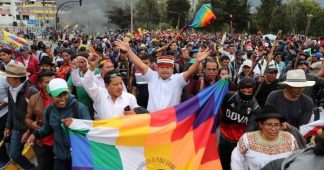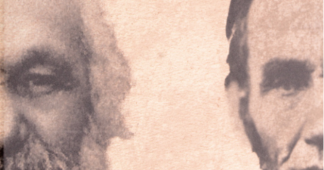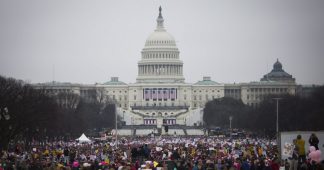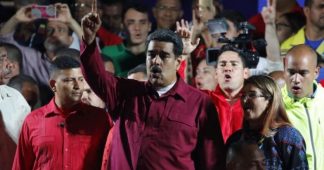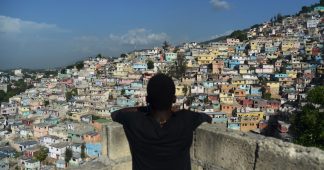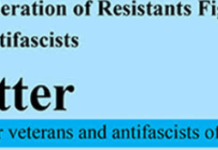«At its root, capitalism not only meant slavery and white supremacy but also the ethos of the gangster. » (Gerald Horne)
By Franklin Frederick
The film ‘Joker’ presents a contemporary phenomenon present in several countries, but which can only be understood in its complexity through the history of the origins of the USA.
African-American historian Gerald Horne argues in the book ‘The Counter-Revolution of 1776: Slave Resistance and the Origins of the United States of America’ that the U.S. independence movement was born, on the one hand, from the fear of the wealthy classes in the colony of a growing abolitionist movement in the metropolis, England, which could put an end to the basis of their wealth – the slaves. On the other hand, England also hindered the advance of the settlers to the west, which was to remain indigenous territory. For Horne, the war for U.S. independence was partly a ‘counter-revolution’ led by the ‘founding fathers’ with the aim of preserving their right to enslave other peoples, mainly Africans, and to continue to expand the young nation to the west, stealing more land from the indigenous peoples where more slave labor would be deployed.
In another book, ‘The Apocalypse of Settler Colonialism: The Roots of Slavery, White Supremacy and Capitalism in 17th Century North America and the Caribbean’, Horne summarized this process:
«Then finally, in 1776, they pulled off the ultimate coup and exhibited their novel display of patriotism by ousting London altogether from the mainland colonies south of Canada, while convincing the deluded and otherwise naive (to this very day) that this naked grab for land, slaves and profit was somehow a great leap forward for humanity.»
In this contextoccurredanother process of fundamental relevance for today: the birth of U.S. military power. The U.S. army originated in the war for independence against the British, which was also a war against the vast majority of African slaves who allied themselves with the British – which promised their freedom – and against the many indigenous peoples who also allied with the British – aware of what would follow for them once the new republic became independent. And indeed, soon after the victory against the British and the established peace, the newly created U.S. army engaged in its new task: the genocidal war against indigenous peoples to secure the territorial expansion of the new republic.
In the book ‘The First Way of War: American War Making on the Frontier, 1607-1814’ author John Grenier argues that the U.S. armed forces were forged in the genocidal wars against American indigenous peoples, when virtually every means of destruction was allowed, all brutality was possible, and there was no distinction between civilian and combatant populations. One of the methods used by the U.S. armed forces against indigenous peoples was the destruction of their plantations and food reserves, leading to defeat by famine, a method widely used and perfected decades later by the U.S. in the Vietnam war, making the U.S. perhaps the only country in the world to specialize in the war against the Vegetable Kingdom. In fact, an unbroken historical line leads from wars against indigenous peoples to the war in Vietnam. The most recent economic embargoes against Cuba and Venezuela are just another form of this method, the objectives remain the same – to cause hunger, to punish civilian populations in order to subdue them – and have been used since the beginnings of US military power. The extermination of indigenous peoples was so central to politics at the time that participating in military campaigns against indigenous peoples was practically a prerequisite for becoming a candidate for the presidency of the New Republic. Andrew Jackson, the seventh president of the United States, is perhaps the one who best represents what this new country really was. Jackson was a wealthy planter and slaveowner, leading troops during the War against the Creek people, which led to the conquest of many lands now belonging to the states of Alabama and Georgia. He also led the US troops in the war against the Seminole people. In the presidency, Jackson continued his crusade against the indigenous people. There is an interesting episode in the well-known TV series ‘House of Cards’ in which Indian representatives visit the White House. As part of the preparations for the visit, White House staff remove the portrait of Andrew Jackson from a wall, apparently in order not to offend the Indians – a rare moment of lucidity in such media. And it was Andrew Jackson’s followers who founded the U.S. Democratic Party…
In order to guarantee a ‘single front’ between the settlers against the indigenous peoples, on the one hand, and to ensure the practice of slavery on the other, the British forged an illusory ‘alliance’ beyond the social classes, between the ‘whites’ – white supremacy – that legitimated and allowed the exploitation, theft or extermination of all those who were not so endowed. According to Gerald Horne, this militarized identity politics that was ‘whiteness’’ was at the root of the colonial occupations as early as 1676, leading to the creation of a ‘white man ‘s’ country, a first ‘apartheid’ state, an example to be followed by South Africa. Violence against indigenous peoples and the violence inherent in the slave economy became common, ‘normal’ elements in the US white mentality to this day. Gerald Horne arguesthat one of the last expressions of ‘white supremacy’ in the mainstream U.S. politics was the election of Donald Trump, as a part of the electorate «(…) could not overcome the poisonous snare of white supremacy. That is, the seeds of the fiasco of an election in November 2016 in the United States, where the less affluent of European descent, including more than half of the women of this group, found their tribune in a vulgar billionaire, has roots in the cross-class coalition that spearheaded colonial settlement in the seventeen century at the expense of the indigenous and enslaved Africans.»
This history and its consequences are very much still present in the Joker. Arthur Fleck, the character in the film, is just one of the millions of poor white men abandoned by the system, and it is not by chance that, in the film, practically everyone who comes into real, emotional contact with Arthur Fleck, is African-American, including the only woman he cares about. In this way, the film places white Arthur Fleck in the middle of a poor Afro-American community, that is, according to the myth of white supremacy, completely out of his ‘natural’ place. The social worker who allows him to get the medicine he needs is Afro-American and, when she informs him about the closure of the socialcentre – another result of the austerity policies of neoliberalism – she comments: ‘They don’t give a shit about people like you. Or like me.’ – They’, in this case, being a clear reference to the powerful, to the 1%. There is a permanent possibility of a haven for Arthur Fleck within the African-American community, as the social worker recognizes by placing the two as victims of the same system. But Arthur Fleck is unable to see or understand his situation in the broader context that would open him up to the dimension of solidarity with the African American community and others and, as I see it, it is his ‘whiteness’ that blinds him to this possibility. Instead, following the illusions of his adoptive mother that became hisas well, he tries hard to be accepted again by the successful white community. The ‘alliance’ beyond the social classes that connects whites in the myth of white supremacy is still sufficiently strong in Arthur Fleck’s unconscious to take him to Thomas Wayne seeking the ‘recognition’ of his ‘natural right’ to belong to Wayne’s successful white community, a way of updating the ‘alliance’ of white supremacy, just as so many impoverished and marginalized whites voted for Donald Trump did.To reinforce the image of unity of this white community, the dialogue with Thomas Wayne takes place in a theatre full of white people celebrating the success of their social class. Thomas Wayne does not recognize his “fatherhood” – the symbolism here is clear – of Arthur Fleck and, even worse, violently refuses any contact with him, thus revealing the lie of the white ‘alliance’, the myth of racial supremacy as a bond between whites beyond social classes.
Thomas Wayne’s punch shows that such an alliance never existed.
But there is a gesture of solidarity shown in the film that really belongs to the ‘white alliance’: knowing that Arthur Fleck suffered an aggression in the street, one of his co-workers offers him a weapon to defend himself – the gesture of solidarity par excellence of the ‘white alliance’. The neo-fascist Bolsonaro is his campaign for the presidency in Brazil did exactly the same, just in a much bigger scale. he promised to put weapons more easily within reach of everyone, especially his supporters, who promptly rewarded this ‘solidarity’ by helping to elect him.
The moment when the myth of the ‘white alliance’ really explodes in the film is the sequence of the fight in the subway. Three well dressed and visibly successful white youths harass a woman sexually–feeling perfectly right in doing so, the “normal” behaviour of the white heterosexual male, in the U.S. as in Brazil. Arthur Fleck, with his nervous laughter, hinders the three young men who turn against him. Arthur Fleck is obviously poor, a clown, of a social class much inferior to that of the three young yuppies who start to assault him violently – betraying the ‘white alliance’ like Thomas Wayne – but Arthur Fleck has a weapon and, for the first time, gives way to his years of accumulated frustration and repressed anger – and kills his aggressors. For Arthur Fleck this moment is liberating and from then on, he feels stronger but also “goes crazy”, the symbolism used, I believe, to show the emotional price paid by Arthur Fleck for betraying his part in the white ‘alliance’. His oppressive violence was directed against white people, not against Latinos, black or indigenous immigrants – the ‘normal’ targets of white supremacist violence. The “white” liberal public conscience, represented in the film by the character of Robert de Niro , Murray Franklin, an idol for whom Arthur Fleck also aims to be somehow recognized, condemns the murder of the three ‘promising young people’, because in this case the solidarity of the white ‘alliance’ really exists – as CLASS solidarity – the three were ‘successful’, obviously members of the dominant class. Three poor whites like Arthur Fleck murdered in the subway would certainly have no press attention, it was the social class of the three murdered that awakened, on the one hand, the sympathy of the Murray Franklins, and, on the other hand, the popular revolt that is the background of the film. Arthur Fleck repeatedly declares himself without any political awareness or political objective. The Arthur Flecks of real life hardly vote, but if they do, they vote for Donald Trump or Jair Bolsonaro. The Arthur Flecks’ revolt is limited to spreading violence, ‘paying back’, creating chaos, it has no political content, it does not aim to change the system, the Arthur Flecks do not even have the slightest idea how the system really works, they only feel unjustly frustrated by something they can only react to with violence. Arthur Fleck is the potential fascist, what unites them, in the U.S. as in Brazil, is still the mystique of the white supremacy, the feeling of belonging to the dominant class, a kind of ‘natural right’to be privileged, to have prestige and power. For the capitalist system, the Arthur Flecks have an enormous importance, because they not only elect the Donald Trumps and the Jair Bolsonaros, allowing the international oligarchy of the capital to continue through them to dominate the world; but even more, the Arthur Flecks have the fundamental role of depoliticize society, of preventingpublic consciousness to focus on real issues. And it is through violence, intimidation, the attack on institutions, culture and everything that threatens their ‘white’ identity that the Arthur Flecks fulfil this role. The Thomas Waynes smile, the 1% rejoice at such stupidity so easily manipulated in their favour. And Thomas Wayne is not only a Gotham City type, there are many Thomas Wayne all over the world, as many in Brazil and Argentina as in Europe. All of them breeding the “Batmen” eager to fight “corruption” in the name of the Capital.
But ‘Joker’ also shows, even if only obliquely, the possibility of redemption for Arthur Fleck. What if Arthur Fleck managed to get out of his emotional prison, out of his whiteness ‘poisoning’ – to use the expression of Gerald Horne – and sought help and refuge in the African-American community? African-Americans have a long history of political consciousness and struggle, they have faced the violence of white supremacy from the beginning, they know what it means, they know its extent and also its main weaknesses. Above all, African-Americans know very well that the struggle is political. The greatest nightmare, the greatest threat to the U.S. oligarchical political system is precisely the solidarity union between the Arthur Flecks and the Afro-American community, witth the consequent politicization that this union implies. The system, the international financial oligarchy, may well coexist with chaotic violence, with brief outbreaks of destruction and social conflict – in fact, this violence is even useful for the system and for the oligarchy, among other reasons because it can be used as a pretext for more repression and violence on the part of reactionary forces. But what the system cannot support is rebellion WITH POLITICAL CONTENT – as we see now in Chile, Argentina or Ecuador.
The Joker portraits the ending of white supremacy because even the Arthur Flecks are already realizing that “whiteness”,this ‘solidarity alliance’ among“whites”, which for so long has fed them until it became the foundation of their own being, is nothing but a lie woven by the 1% – mostly whites – to better exploit all the others.
And meanwhile in Latin America, Argentina, Ecuador, Chile, Bolivia, and Venezuela, the political consciousness of the people has long since overcome the myth of white supremacy and “whiteness” loyalty to the oppressors and subservience to the international capital. There is a plural humanity, rich and proud of its many colours, genders and ways of being that increasingly assumes political control over its own destiny. It is this humanity that, with much clarity, determination and joy, is defeating fascism and the myths that support it.
